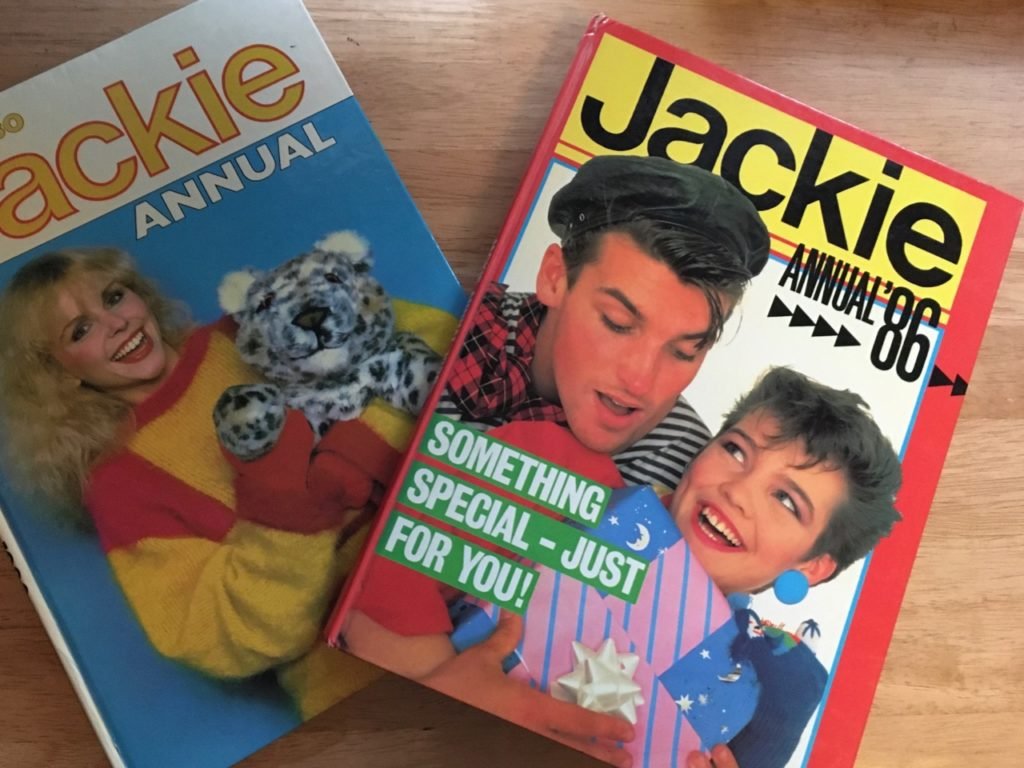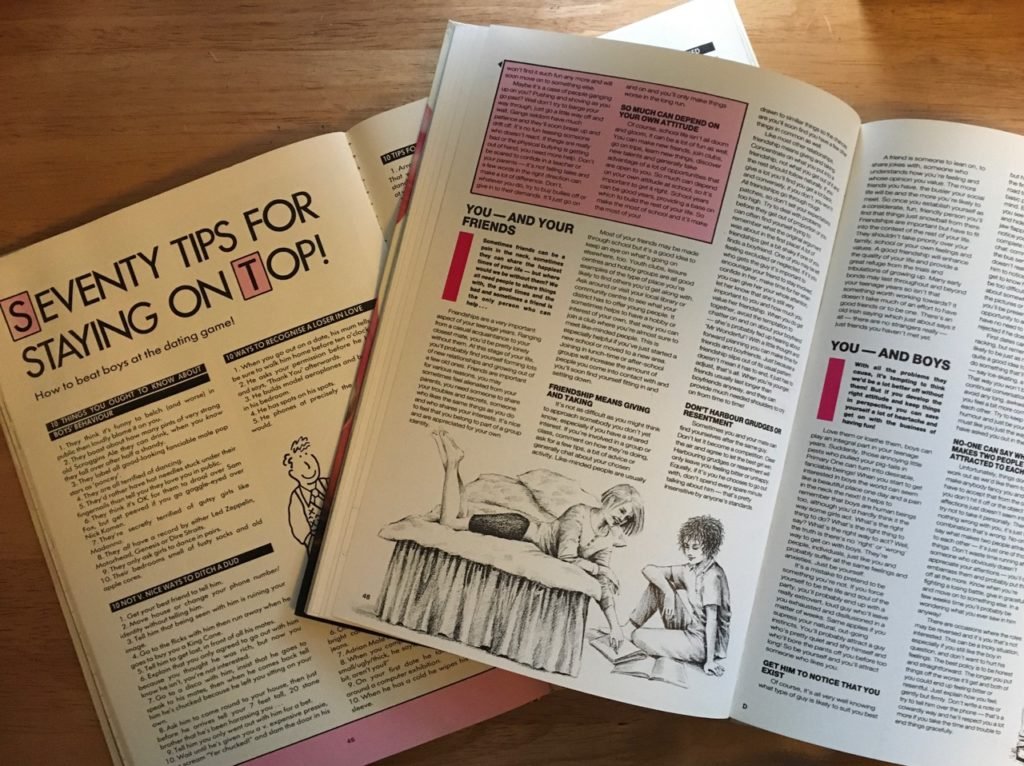
In April 2019, I gave a paper, “How did portrayals of ‘disruptive sex’ change for teenage girls in the magazines of 1950–2000?”, at the Rethinking Disruptive Sex conference at LSHTM; my paper referenced WRAP paper 4, ‘Learning about sex’, by Rachel Thomson and Sue Scott. Later at the same conference, Rachel spoke about WRAP in connection with her current reanimation project that explores changes and continuities in girls lives and gendered sexual cultures over the past 30 years.This started a conversation about possible connections between the WRAP data and my own research, which explores girls’ interactions with magazines in the late 20th century.
My research is a historical study that uses readings of girls’ magazines of the late 20th century, and results from a survey of adult women about their recollections of the magazines they read as teenagers. Many of these women were reading the same late 1980s and early 1990s magazines that the original WRAP participants could have read. My research focuses on the letters that girls wrote to magazines, exploring the ways in which they engaged with and critiqued magazine content. What’s clear from the letters that girls wrote to magazines, and which repeatedly emerged from my survey results, was that girls had very limited ways of accessing information about sex. They described being unable to talk to their parents, having no siblings (especially those who have no brothers needing to learn about boys), and about the inadequacies of the school curriculum in covering these topics. Both the WRAP data and my survey data make it clear that for some girls, magazines were able to fill this gap and provide some straightforward, helpful advice:
[I learned] Far, far more about sex and relationships [from magazines] than I would otherwise have known; safe sex, healthy relationship advice that no-one else was giving.
(My survey respondent 1)
Jackie magazines were quite good actually. They’re really sexist but they were good for things like [periods].
(WRAP interview ALS20)
Girls were not all uncritical readers – some of them recognised that much of what they read was romantic generalisations, which turned out to be at odds with the girl’s experience of relationships with boys:
[I read] Jackie, and My Guy, and […] You know you just get an idea somehow from these magazines that the boy will take you out, and will be really nice to you, and at the end, they’ll kiss, and you think […] That’s the way it’s meant to be
(WRAP interview MAG12)
The lifestyles described seemed so far from my own that it was more like reading fiction than fact. Especially […] ‘dating’ as an event rather than something you sort of slipped into. The idea of ‘going on a date’ was totally alien to us.
(My survey respondent 9)

Nevertheless, magazines remained a major source of information for these girls, and the 1980s and 1990s represented something of a turning point in the way they covered sex and relationships. The girls’ magazines earlier in the 20th century were navigating a difficult balance between the dangers of too little information, and social pressures opposed to magazines offering too much information. In the 1980s however that balance slowly began to change, in the wake of influences including AIDS and second wave feminism. In girls’ magazines of the 1970s and earlier, coverage of sex was almost exclusively along the lines of ‘boys want it, and it’s up to girls to say no’, with no acknowledgement of any reason girls might want to say yes at any point before marriage. In the 1980s, that began to change, as demonstrated by this reader letter published in Jackie:
I’m 17 and I have a boyfriend I love very much. I’ve been having sex with him for over a year and up until now I’ve been lucky, but one day I won’t and I’ll get pregnant. We usually use a condom, but I’m still worried. I mean to say ‘no’, but I love him so much I can’t.
(Jackie, 9 May 1987, p. 25)
The landscape had changed enough that the magazine response entirely ignores the last sentence, and focuses instead on advice about contraception. Teenage sex between couples who are in love (perhaps especially when the girl means to say no) was no longer always frowned upon.The WRAP captured similar experiences of women who were having regular unprotected sex with a partner – knowing that they shouldn’t, scared they might get pregnant, but unsure how to have the conversation about contraception or to know who to turn to for help and advice.
QU: This boy you went out with for 9 months. Did you use any contraception?
(WRAP, interview AMB18)
AN: No.
QU: Why?
AN: Cos he wouldn’t wear a condom, I weren’t on the pill.
QU: Were you worried about that?
AN: Yeah.
QU: Was he?
AN: Yeah, both of us was really. I kept on thinking, oh no, I’ve got.. [unclear]…yesterday.. I was really scared, I thought, cos I came on early, so I thought, what’s happening, what’s going on? It’s quite unlike me to come on two weeks early.
Experiences like these sometimes prompted girls to write in to magazines to try and help others learn from their example, as in this letter in the Just Seventeen problem page:
Recently, I was at a party and met a boy I thought was really nice. We both got drunk and ended up having sex without contraception. I wouldn’t have done it if I’d been sober, and afterwards I felt so cheap and dirty. I was a virgin before this happened and I’d always hoped that when I lost my virginity it would be with someone I cared for, and it would be a loving and pleasurable experience. It didn’t turn out that way. When my period was late, I became so worried, thinking I must be pregnant. Eventually, my period arrived late and the relief I felt has led me to write this letter. I feel I nearly ruined my life because I got drunk, and I’m never going to let this happen again. I’ve learned my lesson the hard way, and hope you print this to help other people realise how stupid it is to behave like this.
Tricia, Edinburgh. (16 November 1988: 51)
Just Seventeen at this point carried quite a few similar letters from girls who had taken risks with sex and wanted to help others avoid making the same mistakes, despite the fact that they themselves must have previously read similar stories and made the mistake anyway. This is however, part of increasing acceptance in the magazines of girls’ sexuality, and experimentation with sex, even if in sometimes-risky ways.

The late 80s was also the era of a beginning discussion in girls magazines about pleasure in sex for girls and women, which participants in both my survey, and the WRAP interviews, picked up on, albeit somewhat tangentially:
I just sort of knew vaguely that women can have orgasms [from] problem pages
(WRAP interview MAG12)
I learnt the word ‘orgasm’ in magazines, and an awful lot of tips for pleasuring boys. Disturbing considering the age bracket…
(My survey respondent 27)
So although magazine readers of the late 1980s and early 1990s discovered the theoretical possibility of pleasure in sex for women, it would take longer for this to translate into the right to expect pleasure. The conversation was still focussed on girls’ right to say no to sex, with the possibility of saying yes often only implicit in the discussion, or otherwise portrayed as problematic in some way. For example, 19 magazine, aimed at older teenagers, ran an article in 1991 about girls who sleep around, which includes the statement that ‘girls have as much right to do it as boys’, but moderates that right with questions about their motives in doing so:
But are they really happy? Tricia Kreitman thinks not. ‘There is something missing in these girls’ lives,’ she says. ‘They are looking for a sense of worth, to feel attractive and wanted, and they are hoping to find it through sex.’
(March 1991, p. 16)
This example from Just Seventeen is unusually explicit about girls right to say ‘yes’ to sex and in its critique of the slut-shaming discourse that could be read elsewhere:
[T]he only reason why you should have sex […] Because you want to. That means not feeling threatened or bullied and not having sex to appear mature […] being a virgin is nothing to be proud of or ashamed of. You shouldn’t feel inadequate if you’re lacking in experience, or ashamed if you have had sex before […] If you feel ready to have sex with your partner, there’s no reason why you shouldn’t make the first move. It doesn’t mean you’re “loose”. Just that you’re taking the lead.
(Just Seventeen, 15 June 1988, p. 37)
The WRAP captured young womens’ experiences of negotiating sex and relationships against this shifting and often contradictory backdrop. Interviewees were frequently asked about their experiences and expectations of pleasure in sexual relationships and although the authors of the study concluded that sexual pleasure was largely ‘missing’ from women’s experiences of heterosexuality there were also examples of young women enjoying sex and trying to make sense of their pleasure using the limited discursive frameworks available to them, as this field note shows.
First sexual rel. at 15 with a 17 year old boy. Did it because she wanted to, says she was not pressured. Her mum is a health visitor and wanted her to stay a virgin until she got married, she didn’t think that that was realistic anymore.
Present relationship with a boy who she thinks she will stay with permanently. I asked her what made him different and one of the central reasons was that he was good in bed, and/or she actually enjoys sex with him. This lead to a conversation about expectations of sexual pleasure. I asked her if men and women had sex for same reasons, she said that women had sex for different reasons, they were more interested in the emotional side and men in the physical.
(Fieldnote for interview AMD10).
Despite the increasingly liberal approach to young women’s sexuality in girls magazines, participants in both WRAP and my own study looked back at their younger magazine-reading selves with some anxiety, and took pains to distance themselves in their present-day critical-thinker personas:
I think […] you always sort of learn things from magazines but I don’t know whether they’re the right things. Because they are all biased aren’t they especially the problem pages.
(WRAP interview BT08)
I didn’t really know how to read this critically, I just absorbed everything.
(My survey participant 55)
Some readers of the magazines did, however, read critically, and some magazines even encouraged this. Mizz in the 1990s was one such, running frequent debate articles on topics like abortion, and sex before marriage, featuring readers arguing the case and responding to each other; the magazine also encouraged readers to write letters arguing with things they’d read in the magazine, and frequently published these. Also appearing in the 1990s, a few years too late for the WRAP participants, was a magazine which whole-heartedly endorsed pleasure in sex for women and girls: more!, fondly remembered by my survey respondents for the ‘position of the fortnight’ and the idea that sex should be fun:
I remember that more! was really sex positive. Giving positions of the week and generally telling girls how to enjoy sex.
(My survey respondent 11)
Every issue of more! in that period contained a double-page spread on sex, including the position of the fortnight, reader letters, mini articles and trivia, as well as the usual amount of sexual content on the main problem pages. But readers’ recollections of this are coloured by their adult ideas about age-appropriate reading matter, for example:
In more! they had ‘position of the fortnight’ which I always thought was quite highly sexualized given the reading age.
(My survey respondent 31)
The WRAP interviewees who complained about the content of their magazines might have been consoled by some small improvements in these magazines in the following decade, with magazines like Mizz encouraging readers think critically about the world around them, including about issues of sex and romance, albeit while still portraying a world where girls must act as gatekeepers for the sex that boys want from them. For the daughters of the WRAP interviewees, and the daughters of my respondents, seeking information about sex in the twenty-first century is a very different proposition. There is infinitely more information available, but finding the good stuff in amongst the bad can seem impossibly difficult. The next challenge may be how to help today’s young women to navigate that.

